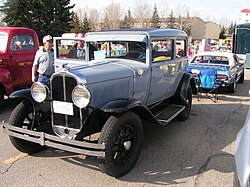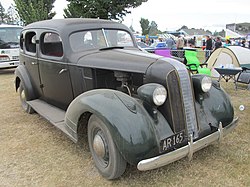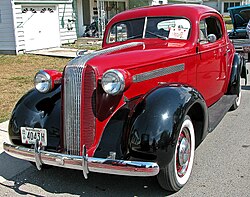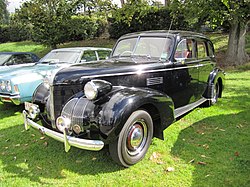First generation (1926-1932)
The 1926 Pontiac 6 was first introduced as the Series 6-27 using Fisher Body coachwork, and only offered a 2-door 2-passenger Coupe or 5-passenger Coach with a list price of US$825 [1] ($14,653 in 2024 dollars [2] ). It was first introduced January 3, 1926, [3] while manufacture at the Oakland Factory in Pontiac, Michigan. began December 28, 1925 and introduced the Pontiac straight-6 engine split-flathead which was designed by Henry M. Crane. [4] As this was an entry-level vehicle, options were limited to a front and rear bumper, rear mounted spare tire and a heater for the passenger compartment. The Coach came painted in Sage Green with Faerie Red striping, and the Coupe in Arizona Grey, with landau bars on the roof; both came with black fenders. Mid-year changes were introduced in August adding three more body styles. The coupe was available in blue with a red stripe, the coach was available in blue or gray with an orange stripe. Deluxe models could be distinguished by having both the fender and body in one color. A total of 76,742 cars were produced the first year. [1]
When model year 1927 began, the car was renamed the "New Finer Series 6-27", and a Sport Roadster or Sport Coupe with optional rumble seat was offered as a 2-passenger. Prices reflected the popularity of the brand, and ranged from US$775 ($14,029 in 2024 dollars [2] ) for a choice of the Sport Roadster, 2-passenger Coupe or 2-door 5-passenger Coach to US$975 ($17,649 in 2024 dollars [2] ) for the Deluxe Landau Sedan. [1]
Earlier in 1925, the GM Art and Color Section, headed up by Harley Earl standardized all GM products and continued the tradition of planned obsolescence, which introduced yearly appearance, mechanical upgrades or new optional equipment that in later years became standard equipment, and the 1928 Pontiac 6 "New Series 6-28" was the new sales leader favorite of GM and saw various changes too. The front fenders now had a higher crown which meant that the edge of the fender came further down the sides of the tires and covered more of the front of the tire with a beaded edge. All previous "Deluxe" models were renamed "Sport", and the Indian head hood ornament no longer had a headdress, which now signified it was using the likeness of an Indian brave. Prices remained under US$1,000 for all coachwork choices. [1]
January 1929, the updated Series 6-29 "New Big 6" was introduced, signifying that the engine displacement was now at 200 ci, and styling was now influenced by the Vauxhall 20-60 which GM had previously purchased in 1925. [1] All vehicles built between August and October 1929 were identified as Series 6-29A. Some of the improvements recorded were appearance, mechanical or feature enhancements to include a vertical center divider on the surface of the radiator, vertical louvers on the sides of the engine cover, oval opera windows on closed body sedans, and a combination transmission and ignition lock. [1]
When the Wall Street crash of 1929 occurred in September, both Pontiac and Oakland sales dropped dramatically and because Oakland was the more expensive, GM leadership decided that Pontiac should remain. [1] January 1930 introduced the Big 6 Series 6-30B and some of the improvements recorded were a rearward sloping windshield, a beltline molding that extended around the exterior, and exterior sun visors above the windshield. Wheel dimensions were measured at 29" and model year production dropped to 62,888. [1]
For model year 1931 the "Fine 6 Series 401" was introduced in January, and the most notable changes were a 112" wheelbase, seven body style choices, while it shared appearance and technical advancements introduced by GM on all cars for this model year. This was the last year for Oakland, and prices remained close in comparison to Chevrolet at US$675 ($13,956 in 2024 dollars [2] ) for a choice of a 2-passenger Coupe or 2-door 5-passenger sedan to US$785 ($16,231 in 2024 dollars [2] ) for the 4-door 5-passenger Custom Sedan. Model year production improved to 84,708. [1]
1932 was the first year that Pontiac offered two products, with the Series 302 V8 being renamed from the previous Oakland Model 301 V8. The Series 402 Six offered the same appearance, mechanical and optional equipment installed on all GM vehicles that year, a 114" wheelbase, including the availability of a radio, relocating the sun visor to inside the vehicle, replacing the vertical engine compartment vents with individual doors, fender lights on deepened crown front fenders, and sharing the curved front bar between the headlights used on the 1932 Chevrolet. Kelsey-Hayes spoked 18" wire wheels were optional covering four-wheel mechanical drum brakes. [1]
1927 Pontiac Series 6-27 Sport Sedan
1928 Pontiac Series 6-28 coupe
1929 Pontiac Series 6-29 coupe
1931 Pontiac Fine 6 Series 401 Custom Sedan
1930 Pontiac Series 6-30B Sport Roadster
1932 Pontiac Series 402 2-door 5-passenger sedan














